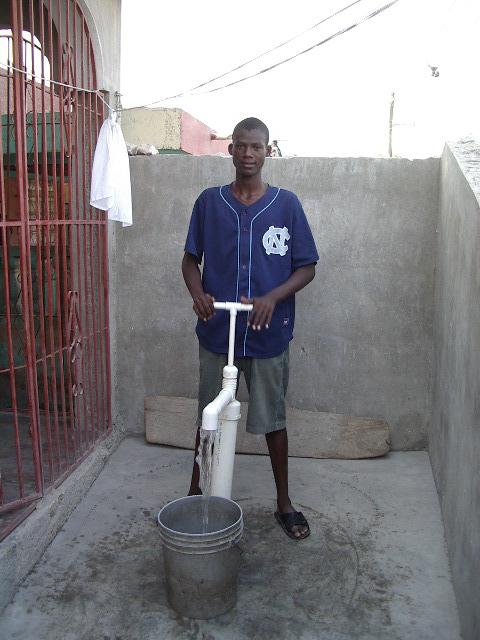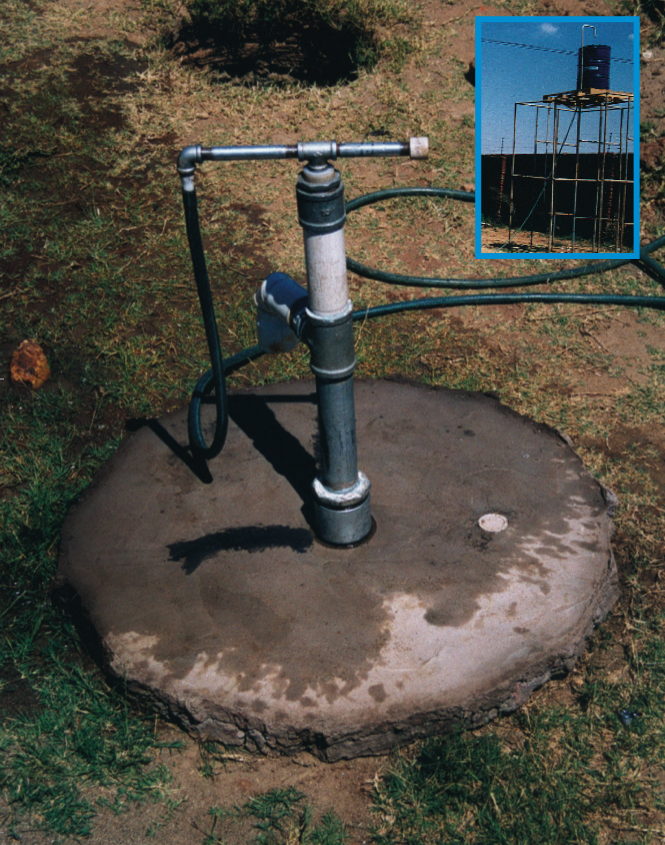PVC pumps
| |
|
|
|
|
|
|
|
|
|
The name PVC pumps covers a large number of different hand pump designs, which have in common that most parts are constructed out of PVC. PVC is used because it is often cheap, and easy to work with. As PVC is less durable as other materials such as steel, a single PVC pump should be used by a limited number of people. Because of the low price, PVC pumps are often used as family pumps. Sometimes other types of Plastic are used, such as ABS, which is UV resistant.
There are many types of PVC pumps, differing in design aspects such as direct action versus lever operated, piston rod versus piston pipe, single or double action, with or without a water seal. The valve designs vary from ball valves, rubber flap/butterfly valves and bicycle inner tube valves to bolt valves, pvc adapter valves, and washer valves.
Examples of PVC pumps are the EMAS pump, the Canzee pump and the DTU pump. Some pumps are described in their own Akvopedia articles, reachable by clicking on the links above.
Some pumps, such as the EMAS pump are deep well pumps, and can pump water over a height difference of 40m. Others, such as the Canzee pump pump water up to 12-15 m deep. The DTU pump is used for extracting water from underground rainwater catchment cisterns.
Because of their lightweight and low-cost design, PVC pumps are mainly suitable to be used by families or small groups of families. PVC pumps are not recommended for use by large groups of people, as this will lead to the need of frequent maintenance. An excellent overview of community hand pumps, which are suitable for larger groups, is available at the RWSN website1.
These pumps are very popular for domestic use, as shown by 20,000 water systems in Bolivia, which are made with locally available PVC tubing and valves made with marbles. PVC pumps are used in Malawi and Brazil and many other countries in combination with water storage tanks, for example in the kitchen. When used with a storage tank near the roof in a kitchen, running water becomes available in the kitchen, often considered a great luxury.
Because the water is pumped immediately to the storage tank without intermediate handling, the quality of the water remains good and the risk or recontamination is greatly reduced.
Contents
Suitable conditions
| Advantages | Disadvantages |
|---|---|
| - Low cost - Can be locally produced and sold |
- Not suitable for large number of users - Normal PVC degrades through sunlight |
Construction, operations and maintenance
An important issue with all PVC pumps is the tendency of PVC to become brittle when exposed to direct sunlight for some time. Some pumps, such as the Baptist and EMAS pump, solve this by having a concrete pillar around the PVC tube, and by constructing the handle part out of galvanised steel pipe. Other pumps, such as the Canzee pump, use the UV-resistant plastic ABS. The negative effects of sunlight can be partly avoided by shielding the pump from direct sunlight, by painting PVC parts, or by protecting the PVC in some other way. In Bolivia, a strip of cloth is wound around the PVC parts, and held together with a piece of metal wire.
The operation of PVC pumps varies from design to design. Most pumps have a handle which is pushed up and down. The EMAS pump pumps water on the downstroke, in which water is pushed up through the piston pipe. This has the advantage that pressure is created, with which the water can be pumped over a distance or to a higher location. When pumped over a long distance, it is advisable to use an airchamber made from a soda bottle to even out the flow of the water, which increases the efficiency.
Many of the PVC pump designs, such as the EMAS and Baptist pump can be made locally. The Canzee pump can also be made locally, but needs UV-resistant PVC tube.
Maintenance
The maintenance that is needed depends on the design of the pump. In some designs, the bottom valve will need to be replaced periodically. Valves are often made of rubber.
Costs
PVC pumps can be made very cheap. An EMAS pump can be made for about 5$, with 1$ extra for every meter of depth.
Manuals, videos and links
- Info on Canzee pump by Bushproof. The the Canzee pump can be downloaded.
- EMAS pump Akvopedia article
- EMAS Vimeo channel
- BRAND, A. P. (2004) Low-cost pump alternatives for rural communities in Honduras. Meeting demand for access to safe drinking water, Water and Sanitation Program (WSP), Lima, Peru
- Information on the Baptist pump
- Low cost handpumps for water extraction from below ground water tanks by DTU.


